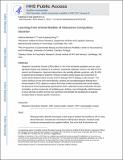Learning From Animal Models of Obsessive-Compulsive Disorder
Author(s)
Monteiro, Patricia; Feng, Guoping
Downloadnihms696272.pdf (828.8Kb)
PUBLISHER_CC
Publisher with Creative Commons License
Creative Commons Attribution
Terms of use
Metadata
Show full item recordAbstract
Obsessive-compulsive disorder (OCD) affects 2%-3% of the population worldwide and can cause significant distress and disability. Substantial challenges remain in the field of OCD research and therapeutics. Approved interventions alleviate symptoms only partially, with 30%-40% of patients being resistant to treatment. Although the etiology of OCD is still unknown, research evidence points toward the involvement of cortico-striato-thalamocortical circuitry. This review focuses on the most recent behavioral, genetics, and neurophysiologic findings from animal models of OCD. Based on evidence from these models and parallels with human studies, we discuss the circuit hyperactivity hypothesis for OCD, a potential circuitry dysfunction of action termination, and the involvement of candidate genes. Adding a more biologically valid framework to OCD will help researchers define and test new hypotheses and facilitate the development of targeted therapies based on disease-specific mechanisms.
Date issued
2015-05Department
Massachusetts Institute of Technology. Department of Brain and Cognitive Sciences; McGovern Institute for Brain Research at MITJournal
Biological Psychiatry
Publisher
Elsevier
Citation
Monteiro, Patricia, and Feng, Guoping. “Learning From Animal Models of Obsessive-Compulsive Disorder.” Biological Psychiatry 79, 1 (January 2016): 7–16 © 2016 Society of Biological Psychiatry
Version: Author's final manuscript
ISSN
0006-3223